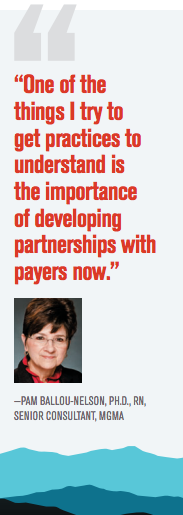Article
2018 payment outlook shows new opportunities, old challenges
Author(s):
New opportunities, old challenges
What a difference a year makes.
RELATED: Are physician incomes falling?
Twelve months ago physicians were preoccupied with Medicare payment reform, which was just taking effect, and wondering how-or whether-to gather and submit the data the law requires to avoid a reduction in Medicare reimbursements in 2019.

Many practices are still coming to grips with the Medicare Access and CHIP Reauthorization Act (MACRA), the law that overhauls how doctors are reimbursed for treating Medicare beneficiaries. But the new year also brings fresh revenue-generating opportunities for primary care practices in the areas of chronic care management, telehealth and diabetes management, along with an expanded number of practices exempt from MACRA’s quality data reporting requirements.
Even with these new possibilities for additional income, though, doctors should continue to look for ways to get the most out of their existing sources of revenue. They can do so, according to practice management experts, by regularly reviewing existing payer contracts, ensuring they are properly documenting and coding patient encounters, and demonstrating their value to payers.
FURTHER READING: Is your practice's location financially hurting you?
“One of the things I try to get practices to understand is the importance of developing partnerships with payers now,” says Pam Ballou-Nelson, RN, Ph.D., senior consultant with the Medical Group Management Association (MGMA). “They need to understand the insurance company’s objectives and ask themselves: ‘How do we as a practice match with those? What is the value proposition we bring to the table?’”
New revenue opportunities
The new prospects for practice income are spelled out in the 2018 Medicare Physicians Fee Schedule Final Rule, which the Centers for Medicare & Medicaid Services’ (CMS) released in November. Among other provisions, the Rule:
- Creates a separate billing code for collecting and interpreting patient health data from remote monitoring devices;
- Creates new billing codes for telehealth services; and
- Expands Medicare’s existing Diabetes Prevention Program and creates a fee schedule for the program’s services.
In addition, the Rule exempts more practices from having to participate in the Merit-based Incentive Payment Program by raising the participation threshold to $90,000 in Medicare Part B allowed charges or 200 Medicare Part B patients. The 2017 threshold was $30,000 in charges and 100 patients.
Next: Remote monitoring
Remote monitoring
The code for monitoring data from remote devices (CPT code 99091) is important for its link to chronic care management services, explains Gary Capistrant, MA, chief policy officer for the American Telemedicine Association. The inability to bill separately for analyzing data tied to chronic conditions such as blood pressure and glucose levels discouraged doctors from using the chronic care management code CMS created in 2015.
“Now that they’re covering the monitoring part, it really makes the management code a lot more attractive,” Capistrant says. “If you team them up, you end up with about $100 per month for caring for a chronic care patient, and that’s without any kind of patient services being rendered or an office visit.

“It’s a huge deal particularly with the number of Medicare beneficiaries with one or more chronic conditions,” he adds. “It will enable a lot more chronic care services to be rendered.”
The new Rule also includes codes allowing doctors to bill several services provided via telemedicine that previously they could only bill for in face-to-face encounters, including health risk assessments, psychotherapy for patients in crisis situations, and determining a patient’s eligibility for low-dose computed tomography.
The codes are part of the agency’s growing recognition of telehealth’s potential for improving healthcare delivery, says Matthew Kremke, MBA, vice president for the American Osteopathic Information Association, the information technology and advocacy subsidiary of the American Osteopathic Association.
TRENDING ON OUR SITE: Top 10 workplaces for PCPs to earn higher salaries
“I think what they’re doing is understanding where the market is going and the need for telemedicine, especially when you’re looking at a senior population or patients who don’t have the ability to get to a physician’s office quickly,” Kremke says.
Diabetes prevention
Another possible source of additional revenue comes from the Rule’s implementation of the Medicare Diabetes Prevention Program (MDPP), which CMS describes as “a structured intervention with the goal of preventing progression to type 2 diabetes in individuals with an indication of pre-diabetes.”
The two-year MDPP consists of 16 intensive group training sessions over six months in dietary and behavioral change for weight control, followed by monthly maintenance sessions extending over 18 months, with the goal of participants achieving at least 5% weight loss. can earn $645 for each patient who completes the program and achieves 5% weight loss, or $670 if the patient achieves 9% weight loss. (See box, “Payment fee schedule for Medicare Diabetes Prevention Program.”) The program takes effect April 1.
Kremke explains that MDPP is designed to encourage doctors to identify patients who are at risk for, or in the early stages of type 2 diabetes. “If you can diagnose a patient as being pre-diabetic or in the early stages of the disease and get them into the system early, the long-term outcomes are much better,” he says. The program will also reimburse suppliers-although at a lesser rate-for patients who attend the training sessions but are unable to achieve their weight loss goals.
Kremke adds that the MDPP addresses a long-standing complaint among doctors regarding a lack of sites to which they could refer diabetic patients for dietary and lifestyle education. And even where such services exist, insurance often doesn’t cover them. “By CMS authorizing this program they’re giving doctors a way to address the needs of such patients,” he says.
Next: MIPS reporting and reviewing payer contracts
MIPS reporting
Meanwhile, of course, MACRA and its attendant reporting tracks-the Merit-based Incentive Payment Program (MIPS) and the Alternative Payment Program remain important concerns for practices. The deadline for reporting 2017 quality data under MIPS is March 31, 2018. The MGMA’s Ballou-Nelson notes that, for the first year of MIPS, practices need only report on one quality measure or one clinical improvement activity to avoid a financial penalty.
“If they’d been reporting on Meaningful Use or the Physician Quality Reporting System in the past, chances are their EHR [electronic healthcare record] system already has a MIPS dashboard set up for them,” she says. However, some EHR vendors may require prior notification that the practice intended to report for 2017, she adds. In such cases, a practice deciding after January 1 that it wanted to report wouldn’t be able to do so.

Ballou-Nelson notes that MIPS reporting requirements become more stringent in 2018. Practices will have to report quality data for a full year, rather than the 90 days required in 2017. Moreover, cost will be included as a performance category for the first time, accounting for 10% of a practice’s overall score. And even though costs will automatically be calculated for them, Ballou-Nelson advises practices to find out where they stand in relation to their peers by reviewing their Quality and Resource Use Report (QRUR), something Medicare develops for every practice that treats Medicare beneficiaries. (The reports are available at portal.cms.gov.)
Reviewing payer contracts
With so much attention focused on meeting the requirements of Medicare payment reform, it’s easy for practices to lose sight of their contracts with commercial payers. But that would be a mistake, practice consultants warn. Practices need to regularly review their contracts to ensure they are financially viable.
“Has this [contract] panned out the way we expected? Are we getting the kinds of volumes we expected when we negotiated this rate? Those are the types of questions practices should always be asking,” says Fred Bentley, MPP, MPH, vice president of Avalere, a healthcare consulting firm.
Ideally, such reviews should take place annually, Bentley says. “But the reality in most smaller practices is that it’s just not feasible, in which case it should be at least every two years,” he adds. “And if it’s not a big part of your payer mix or the company isn’t interested in some kind of innovative partnership you can probably hold off to every three years.”
RELATED: 5 financial mistakes that doctors must avoid
Practice consultant David Zetter, PHR, principal of Zetter Healthcare management consultants, recommends performing a regular “reimbursement analysis” of payer contracts-comparing each payer’s reimbursement to see who pays the most per procedure, using data extracted from the practice management system. That information enables a practice to determine if a contract should be dropped, renewed or renegotiated.
Regarding the latter, Zetter says, “it’s not enough just to say to a payer ‘your rates are too low.’ You need to be armed with information so you can prove to them you know what you’re talking about.”
As part of the reimbursement analysis, Zetter suggests reviewing each contract to see if the insurance company is paying the amounts specified in the contract. “I’ve never done one of these assessments where every payer is paying what they’re supposed to for every code,” Zetter says. “Usually nobody watches this stuff, so payers know mistakes can be made and no one’s going to catch it.”
Sometimes, he adds, a lowered payment is not a mistake, but the result of a payer’s unilateral decision. “Most contracts allow a payer to reduce their reimbursement amounts on specific procedures, or even across the board,” he says. While the company usually has to notify the practice when they make a change, the notification might be on their website, which means that the practice will never see it.”
Next: Coding remains crucial
Looking longer term, MGMA’s Ballou-Nelson says that as value-based contracts become the norm, practices need to ensure they thoroughly understand each contract and what metrics will be used to measure them. “You don’t want to sign something and find out later you don’t have the resources or capability to do what’s in the contract,” she says. “And if you don’t know how you’re doing on a metric they’re going to score you on, you’d better hold off getting into a downside risk contract until you have a better handle on your own data.”
Coding remains crucial
The spread of value-based and risk-bearing contracts also means that practices need to redouble their focus on thorough and accurate coding and documentation. That’s especially important when it comes to risk-adjustment (also known as hierarchical condition category) coding, says Susan Whitney, senior content manager at MGMA.

Without HCC coding, Whitney explains, payers may not get an accurate profile of a practice’s patient base, including factors such as age and morbidity that might make its costs higher than similar practices with whom the payer contracts. That, in turn, could put any shared savings at risk. “If patients aren’t accurately pictured, the practice may well lose out on some money,” she says.
POPULAR ON OUR SITE: 5 ways physicians can avoid retirement failure
Whitney cites the example of a patient complaining of abdominal pain. “Coders know the practice will get paid for the office visit based just on that [abdominal pain],” she notes. “But if the patient also has diabetes or morbid obesity and you tack those diagnoses on, their risk-adjustment score goes higher, and payers start looking at that practice differently.”
The adoption of the ICD-10 code enables payers to obtain far more detailed information about patients’ conditions and diagnoses, Whitney says, and compare them to the practice’s costs. That’s why it’s important for practices to code as specifically as possible, and doctors to provide the documentation to back up the codes.
“A lot of practices haven’t understood how all these factors tie together,” Whitney says. “Now they need to begin connecting the dots so they can collect everything they’re owed.”
















